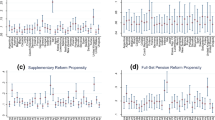Abstract
The paper analyzes the link between the public pension system and the immigration policy. In a pay-as-you-go system, the incentives for immigration vary significantly between individuals at different lifetime periods. In the framework of an overlapping generations model, we show that the median voter's choice in general leads to inefficient levels of immigration. The median voter neglects the effects of the externalities within the pension system on other generations. An immigration policy that is not affected by the median voter's choice but instead is constitutionally determined will avoid welfare losses. The expected lifetime income of each generation can be increased by applying a rule of steady immigration.
Similar content being viewed by others
References
Battis, U. et al. (1988). Alterssicherungssysteme im Vergleich. Regensburg: Verlag Recht, Verwaltung, Wirtschaft.
Bean, C.R., Layard, R. and Nickell, S.J. (1986). The rise in unemployment: A multi-country study. Economica (Suppl.) 53: S1-S22.
Besseling, P.J. and Zeeuw, R.F. (1993). The financing of pensions in Europe: Challenges and opportunities. The Hague: Research Memorandum No. 111, Central Planning Bureau.
Börsch-Supan, A.H. (1993). Migration, social security systems, and public finance. Mimeo. University of Mannheim.
Casmir, B. (1989). Staatliche Rentenversicherungssysteme im internationalen Vergleich. Frankfurt am Main: Lang.
De New, J.P. and Zimmermann, K.F. (1994). Native wage impacts of foreign labor: A random effects panel analysis. Journal of Population Economics 7: 177–192.
Economist (1994). Unclaimed benefits. April 30th, 29–32.
Felderer, B. (1994). Can immigration policy help to stabilize social security systems? In H. Giersch (Ed.), Economic aspects of international migration, 197–226. Berlin: Springer-Verlag.
Hagen, J. von and Walz, U. (1994). Social security and migration in an ageing Europe. London: Discussion Paper No. 1022, CEPR.
Holzmann, R. (1990). Internationaler Vergleich von Alterssicherungssystemen: Konzepte, Strukturen und ökonomische Effekte. In B. Gahlen et al. (Eds.), Theorie und Politik der Sozialversicherung, 141–167. Tübingen: Mohr.
OECD (1991). Controlling government spending and deficits: Trends in the 1980s and prospects for the 1990s. OECD Economic Studies 17: 145–189.
Rizzo, I. (1990). The ‘hidden’ debt. Dordrecht: Kluwer Academic Publishers.
Statistisches Bundesamt (1992). Statistisches Jahrbuch 1992 für das Ausland. Wiesbaden: Metzler Poeschel.
Verband Deutscher Rentenversicherungsträger (Ed.) (1989). Rentenversicherung im internationalen Vergleich. Frankfurt am Main: Metzner.
Zimmermann, K.F. (1993). Immigration policies in Europe — An overview. München: Münchener Wirtschaftswissenschaftliche Beiträge Nr. 93–20, University of Munich.
Author information
Authors and Affiliations
Additional information
The authors are indebted to Bernd Huber, Kai Konrad, Ray Rees, Hans-Werner Sinn, Alfons J. Weichenrieder and Bengt A. Wickström for helpful comments.
Rights and permissions
About this article
Cite this article
Scholten, U., Thum, M. Public pensions and immigration policy in a democracy. Public Choice 87, 347–361 (1996). https://doi.org/10.1007/BF00118653
Accepted:
Issue Date:
DOI: https://doi.org/10.1007/BF00118653




